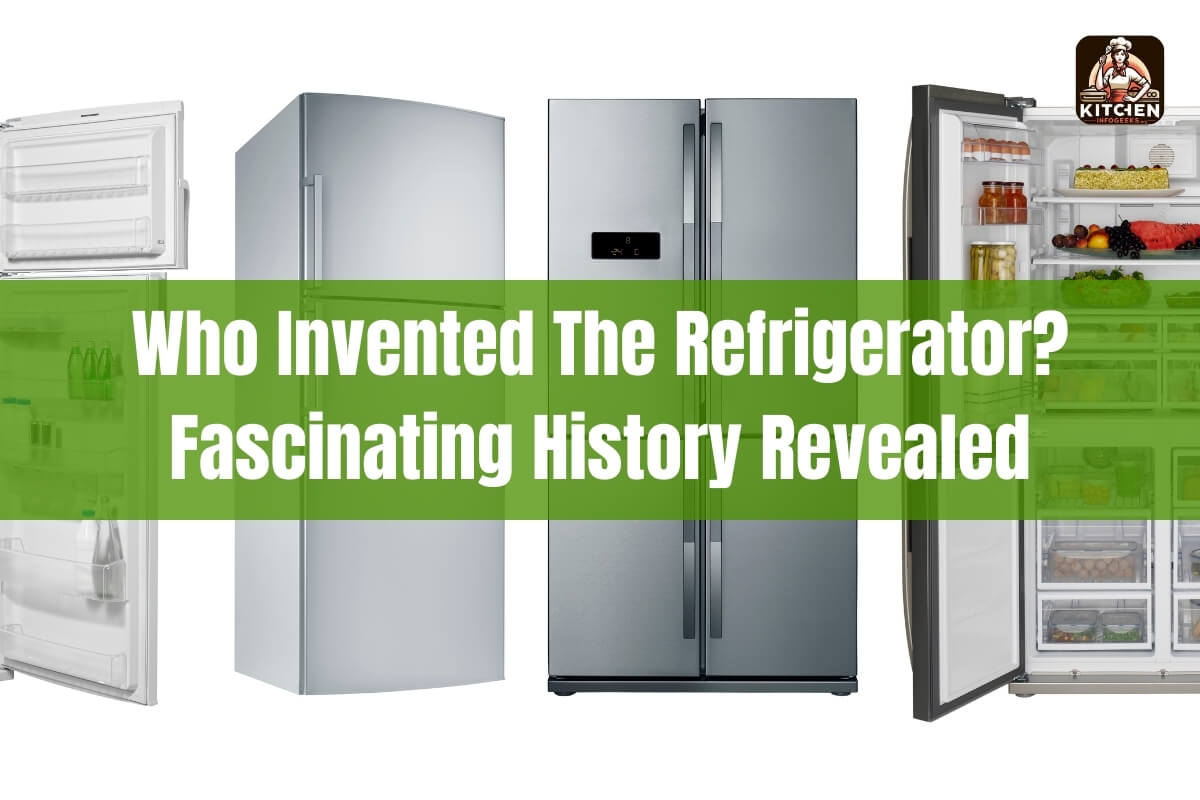
If you’re wondering who invented the refrigerator, the simple answer is that no single person can take full credit. The modern refrigerator we know today is the result of numerous innovations and contributions from various inventors and scientists over several centuries. In this comprehensive guide, we’ll explore the fascinating history behind the invention of the refrigerator, from ancient cooling methods to cutting-edge refrigeration technology.
The Ancient Origins of Food Preservation
Long before the advent of modern refrigeration, ancient civilizations relied on natural cooling methods to preserve their food. One of the earliest techniques involved storing perishable items in cold water sources like rivers, lakes, or even underground pits filled with snow or ice.
The concept of evaporative cooling, which forms the basis of modern refrigeration, was first demonstrated in 1748 by Scottish scientist William Cullen. He observed that the rapid evaporation of liquids like ethyl ether could create a cooling effect.
As populations grew and people moved to urban areas, the need for effective food preservation became more pressing. In the 1800s, iceboxes – insulated wooden cabinets filled with ice blocks – became a popular household solution. However, these iceboxes required frequent ice delivery, which was both inconvenient and expensive.
The Pioneers of Refrigeration
The true pioneers of refrigeration were the inventors who sought to develop mechanical systems for artificial cooling. In 1805, American inventor Oliver Evans designed (but did not build) one of the earliest refrigeration machines that used vapor instead of liquid.
However, it was Jacob Perkins, another American inventor, who is often referred to as the “Father of the Refrigerator.” In 1834, Perkins built the first practical vapor compression refrigeration system, laying the groundwork for modern refrigerators.
Other notable contributors to early refrigeration technology include:
- John Gorrie (1851) – An American physician who patented a method for creating ice to cool air for his yellow fever patients.
- Ferdinand Carré (1859) – A French inventor who developed a refrigerator using a mixture of ammonia and water.
- Carl von Linde (1876) – A German engineer who patented a process for liquefying gases, enabling the use of ammonia and other refrigerants.
Commercial Refrigeration Takes Off
While these early inventions paved the way for modern refrigeration, it wasn’t until the late 19th century that refrigeration technology began to see widespread commercial adoption.
The first documented installation of a refrigeration system in a brewery took place in 1870 in Brooklyn, New York. Over the next few decades, breweries and meatpacking plants across the United States and Europe rapidly embraced refrigeration to preserve their products.
In 1899, American inventor Albert T. Marshall patented the first mechanical refrigerator, further advancing the technology for commercial and industrial applications.
The Advent of Home Refrigeration
As cities grew and people lived farther away from food sources, the demand for home refrigeration increased substantially. Fresh food spoiled quickly, and families needed a reliable way to preserve perishable items in their homes.
In 1913, American inventor Fred W. Wolf introduced the first electric home refrigerator. While bulky and inefficient by today’s standards, Wolf’s invention featured a refrigeration unit mounted on top of an icebox.
It wasn’t until 1918 that the first self-contained home refrigerator with a compressor was introduced by the Kelvinator Company (founded by engineer Nathaniel B. Wales). This marked the beginning of mass-produced domestic refrigerators for the average household.
However, early models were still quite expensive, costing between $500 and $1,000 (equivalent to $6,575 to $13,150 today). As a result, refrigerators were considered a luxury item until the 1930s when safer and more affordable refrigerants like Freon became available.
Refrigerator Innovations Over the Years
As home refrigerators became more common, manufacturers continued to innovate and introduce new features and designs. Some notable refrigerator innovations over the years include:
- Separate freezer compartments (1940s) – To accommodate the growing popularity of frozen foods.
- Water and ice dispensers (1960s and beyond) – For added convenience.
- New configurations – The first bottom-freezer model (Amana, 1947) and the first side-by-side refrigerator (Amana, 1949).
- Color options and design evolution – From basic white boxes to sleek, modern appliances in various colors and finishes (like stainless steel in the 1990s).
- Improved energy efficiency – Thanks to better insulation, compressor technology, and energy-saving certifications like ENERGY STAR.
How Refrigerators Work
At the heart of every refrigerator is the vapor compression cycle, which relies on the evaporation and condensation of a refrigerant liquid.
The refrigerant, a substance like hydrofluorocarbon (HFC) or hydrocarbon, circulates through a closed system of tubes and coils. As the refrigerant evaporates, it absorbs heat from the inside of the refrigerator, cooling the interior.
The resulting gas then passes through a compressor, which increases its pressure and temperature. This hot, compressed gas then enters a condenser coil on the outside of the refrigerator, where it releases the absorbed heat to the surrounding air.
The refrigerant then condenses back into a liquid and passes through an expansion valve, causing a rapid drop in pressure and temperature. This cold liquid refrigerant can then continue the cycle, absorbing heat from the refrigerator’s interior once again.
Refrigerator Safety Concerns
While early refrigerators used toxic and flammable gases like ammonia, methyl chloride, and sulfur dioxide as refrigerants, safety concerns prompted the development of safer alternatives.
In the 1920s, Thomas Midgley Jr. and Charles Kettering discovered chlorofluorocarbons (CFCs), which were marketed under the brand name Freon by DuPont. CFCs were widely adopted as refrigerants due to their non-flammable and non-toxic properties.
However, in the 1970s, it was discovered that CFCs were contributing to the depletion of the ozone layer in the Earth’s atmosphere. This led to the phasing out of CFCs and the introduction of hydrofluorocarbons (HFCs) as a safer alternative.
Today, the U.S. Environmental Protection Agency (EPA) and other regulatory bodies maintain strict guidelines on acceptable refrigerants for use in household and commercial refrigerators. Manufacturers must comply with these regulations to ensure the safety and environmental friendliness of their products.
The Refrigerators of the Future
As technology continues to advance, researchers and companies are exploring even more innovative refrigeration methods for the future.
One promising development is solid-state refrigeration, which uses semiconductors instead of compressors and refrigerant gases. These solid-state refrigerators are virtually silent, vibration-free, and more energy-efficient than traditional vapor compression systems.
Another exciting innovation is magnetic refrigeration, which relies on the magnetocaloric effect – the ability of certain materials to heat up when exposed to a magnetic field and cool down when the field is removed. Companies like Haier and BASF have already developed prototypes of magnetic refrigerators that use water-based coolants and consume up to 35% less energy than conventional models.
As concerns over energy consumption and environmental impact continue to grow, these emerging refrigeration technologies could pave the way for a more sustainable and efficient future.
The Lasting Impact of the Refrigerator
It’s hard to overstate the impact that the invention of the refrigerator has had on human society and daily life.
By enabling long-term food preservation, refrigerators have transformed the way we transport, store, and consume perishable goods. Fresh produce, meat, and dairy products can now be safely shipped across vast distances, ensuring a diverse and nutritious food supply for populations worldwide.
Refrigerators have also influenced our dietary habits and lifestyles, making it possible to store larger quantities of food at home and reducing the need for daily trips to the market.
As we continue to innovate and develop more advanced refrigeration technologies, the legacy of pioneers like Jacob Perkins, Oliver Evans, and John Gorrie will endure. Their contributions have paved the way for a modern world where food preservation is not just a necessity, but a convenience we often take for granted.






